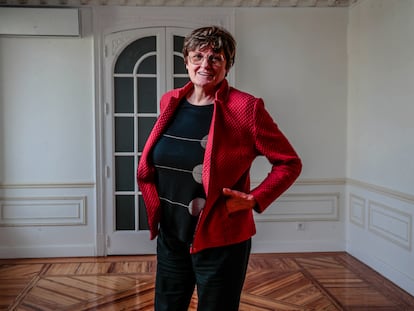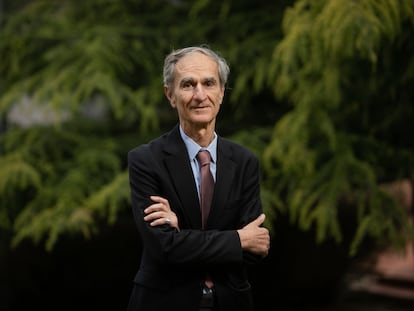A woman immune to pain and anxiety opens new avenues for treatment of injuries and stress
The study of a patient who has rare mutation in her FAAH-OUT gene opens the door to the development of pain relievers that don’t carry the addictive risk of opioids

Joanne Cameron — a 75-year-old woman living in Scotland — is one happy anomaly. A change in the expression of her FAAH gene, which produces an enzyme that processes endocannabinoids and allows them to be absorbed into the body, keeps her in an unusually consistent state of well-being. In Cameron’s body, the levels of anandamide — a substance with effects similar to those of marijuana — are higher than normal. This results in lower levels of anxiety, stress and pain.
In 2013, Cameron’s case reached experts in pain genetics at University College London (UCL), after her doctors realized that she was pain-free after two serious operations on her hip and hand. Since then, researchers have tried to understand what makes Cameron special, so that they can help the millions of people who live with chronic pain and anxiety. At the moment, most of these patients have to rely on inadequate solutions, or dangerously addictive drugs.
Recently, a study led by UCL’s Andrei Okorokov and James Cox was published in the scientific journal Brain. In the paper, the researchers detail some of the particularities of the Scottish patient. For instance, while one in three people have a mutated FAAH gene and higher levels of anandamide in their systems, not all enjoy protection from pain at the same level as Cameron. The paper explains that she has another rare mutation in her FAAH-OUT gene. This gene is found in what is known as “junk DNA” — a region of the genome that, for a long time, was believed to be useless. This flawed logic was due to the fact, despite making up 98% of our genetic material, it is noncoding, which means that it doesn’t contain the information necessary to produce proteins. However, in recent years, these obscure genes have been found to influence how genes that do make proteins are expressed, thus explaining Cameron’s case.
Okorokov states that “the FAAH-OUT gene is a small corner of a vast continent that this study has begun to map out.” In addition to identifying the molecular basis of the absence of pain, this research has determined the way in which the mutation of this obscure gene improves moods or facilitates the healing of wounds. According to Okorokov, “these findings will have important implications for research areas, such as wound-healing or depression.” The researchers observed that, in addition to FAAH-OUT reducing the activity of the gene responsible for removing endocannabinoids from the blood, there are another 348 attenuated genes, but also 797 intensified ones. Among them is WNT16: related to bone regeneration, it also influences mood.
The study is a step forward to harnessing the potential of the endocannabinoid system as a target for treatments against pain — hugely important in a world where around 20% of the population suffers from it chronically and in which the epidemic of addiction caused by the misuse of opioids is alarming. After two decades of tests with drugs that inhibit the FAAH gene, none have been approved. And, in 2016, one of them produced a tragedy in a clinical trial developed in France by the Portuguese company Bial. The drug — intended to treat motor and anxiety problems stemming from diseases such as Parkinson’s — caused poisoning in the brains of the participants. This resulted in the death of one of the test subjects, as well as significant damage in four others. Subsequent research concluded that the molecule had unexpected effects on enzymes other than the ones it was attempting to block.
Javier Fernández, director of the cannabinoids research group at the Complutense University of Madrid, believes that the recent results published in Brain “open up the possibility of directly intervening in the [process of regulating anandamide levels].” That being said, the researcher believes that, from a practical point of view, the findings are still science fiction, “because it’s difficult to take these kinds of [chemical] agents to the places where they’re going to be useful. And, in many cases, they’re ubiquitous enzymes or proteins, so a tool like this can affect many things and have many side effects.” However, he affirms that “it’s a good guide for the future” and that the research “harnesses the value of pharmacological inhibitors, which were somewhat paused by the failed [2016] trial.”
“For now,” he adds, “only Sativex is approved in Canada for cancer pain, but only exceptionally, in compassionate use. There are no other cannabinoid-based drugs approved for pain relief.”
While Fernández acknowledges that the power of cannabinoids to combat pain is less than that of opioids, he emphasizes that “they’re also much safer” and can enhance the effects on our internal opioid system. According to the researcher, one way to take advantage of these synergistic effects would be to combine a low dose of an opioid — which by itself would have no negative effects — with another reduced dose of a cannabinoid. “With this combination, the same effects as the opioids used now would be obtained but without the problems of the epidemic that have been observed in the U.S. and are now beginning to be seen in Europe,” he says.
Andrés Ozaita, professor of pharmacology at the Pompeu Fabra University in Barcelona, believes that, in the future, the knowledge obtained from the study of people like Joanne Cameron may lead to methods that change the way we understand pain treatment.
“By understanding these mechanisms of gene expression, new approaches can be considered, such as gene therapy for people with chronic pain, making the neurons of the dorsal root ganglia less effective and reducing the sensation of pain,” Ozaita says. This type of therapy would consist of the transfer of genetic material to modify the expression of some patients’ genes, to make them more similar to those belonging to people like Cameron. “In the medium-term, I would see this as feasible, especially to treat the most extreme cases, in which other pharmacological approaches are having no effect.”
Although Cameron experiences less anxiety and pain than the average human being, she herself admitted, in an interview with EL PAÍS in 2019, that her gene mutations are not solely advantageous: “I often burn myself in the kitchen […] I don’t realize this until I smell burned flesh. I have many scars on my body. It’s not just a good thing. This [condition] has its advantages and disadvantages. Pain tells you that something bad is happening. And I don’t know.”
Like many other biological variants — which have occurred throughout human evolution — there are no free benefits. “If you do attention or coordination tests [with a patient who has this gene mutation], it’s likely that some traits are affected,” Ozaita says. Additionally, not all difficult circumstances that humans have lived through would have been safe for a person as untouched by physical pain as Cameron. The pain and anxiety that many now suffer from — and that the recent gene mutation study may help alleviate — are, in part, the price of millions of years of survival.
Sign up for our weekly newsletter to get more English-language news coverage from EL PAÍS USA Edition
Tu suscripción se está usando en otro dispositivo
¿Quieres añadir otro usuario a tu suscripción?
Si continúas leyendo en este dispositivo, no se podrá leer en el otro.
FlechaTu suscripción se está usando en otro dispositivo y solo puedes acceder a EL PAÍS desde un dispositivo a la vez.
Si quieres compartir tu cuenta, cambia tu suscripción a la modalidad Premium, así podrás añadir otro usuario. Cada uno accederá con su propia cuenta de email, lo que os permitirá personalizar vuestra experiencia en EL PAÍS.
¿Tienes una suscripción de empresa? Accede aquí para contratar más cuentas.
En el caso de no saber quién está usando tu cuenta, te recomendamos cambiar tu contraseña aquí.
Si decides continuar compartiendo tu cuenta, este mensaje se mostrará en tu dispositivo y en el de la otra persona que está usando tu cuenta de forma indefinida, afectando a tu experiencia de lectura. Puedes consultar aquí los términos y condiciones de la suscripción digital.
More information
Archived In
Últimas noticias
There is as much life left to discover on planet Earth as that which is already known
Dozens presumed dead, around 100 injured in fire at Swiss Alps bar during New Year’s celebration
Is porn for women different from conventional porn? We spoke to those who make it
Cartagena de Indias is sinking: What can the city do to mitigate it?
Most viewed
- Reinhard Genzel, Nobel laureate in physics: ‘One-minute videos will never give you the truth’
- David King, chemist: ‘There are scientists studying how to cool the planet; nobody should stop these experiments from happening’
- Oona Chaplin: ‘I told James Cameron that I was living in a treehouse and starting a permaculture project with a friend’
- Sinaloa Cartel war is taking its toll on Los Chapitos
- The Interoceanic Train, the Mexican alternative to the Panama Canal











































